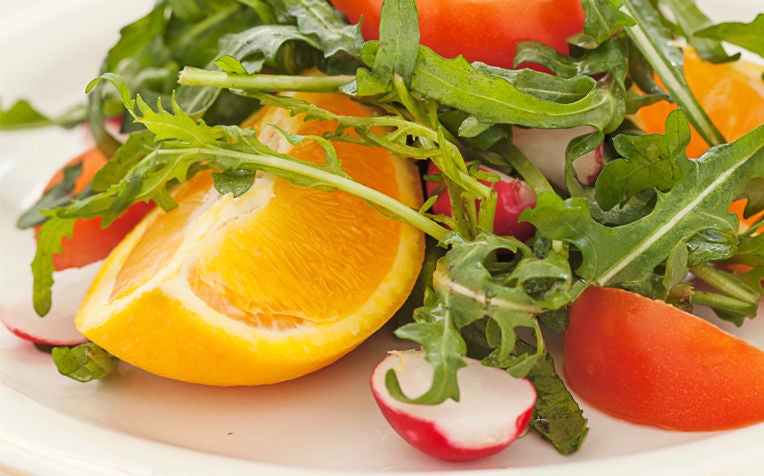
Fruits: Do they ferment in your stomach when eaten with other foods?
Have you heard any recurring old wives' tales about food all your life and wondered if it is true? Forget the latest fad diets, fancy nutrition lingo and trendy superfoods. The key to healthy eating is a well-balanced diet. Experts from Singapore General Hospital (SGH), and Sengkang Community Hospital (SKCH), both members of SingHealth, debunk some popular beliefs.
COMMON MYTHS ABOUT FOOD AND HEALTHY EATING
 It's healthy as long as it's fruit and vegetables.
It's healthy as long as it's fruit and vegetables.
Fact: Not really because the method of food preparation also matters. Dehydrated veggie chips can be high in sodium and the baking process can strip them of the nutrients found in fresh vegetables. Fruit juice can also contain as much sugar as sweetened drinks so you are better off eating the fresh fruit on its own.
 A glass of wine every day is good for your health.
A glass of wine every day is good for your health.
Fact: Although wine – especially red wine – contains antioxidant polyphenols that may protect against cardiovascular disease and cancer, daily consumption of alcohol can damage the liver. It is also a source of calories that can contribute to weight gain. For women, it increases the risk of breast cancer because alcohol disrupts the body’s ability to absorb folic acid, a B-vitamin with anti-cancer properties.
 If fruit is eaten with other foods, it ferments and rots in the stomach, causing indigestion.
If fruit is eaten with other foods, it ferments and rots in the stomach, causing indigestion.
Fact: Fruit can be eaten at any time, and with other foods. The body produces digestive enzymes to help it break down and digest protein, fat, and carbohydrates. Besides, the stomach has a high concentration of hydrochloric acid, which will kill any bacteria before it is able to reproduce. So fermentation cannot take place in the stomach.
 A raw food diet is healthier because heat destroys the nutrients and natural enzymes in food.
A raw food diet is healthier because heat destroys the nutrients and natural enzymes in food.
Fact: Enzymes boost digestion and fight disease. Not many foods can be eaten raw. One has to be careful with raw animal products, including dairy products, seafood and meat, which preferably should be cooked to kill bacteria. Rice, wheat and other grains, on the other hand, need to be cooked to make them more digestible. So a typical raw food diet tends to be plant-based, consisting of fruits, vegetables, seeds, nuts, eggs and some sprouted grains.
Raw food diets tend to lack protein, iron, calcium and certain vitamins such as B12, as these nutrients are more readily available from animal sources.
If one avoids overcooking, there is little harm and plenty of benefit in consuming a mixed diet of raw and cooked food.
 Duck fat and lard are healthier than processed vegetable oils because they are natural and have high levels of monounsaturated fat, which are better for people with heart disease.
Duck fat and lard are healthier than processed vegetable oils because they are natural and have high levels of monounsaturated fat, which are better for people with heart disease.
Fact: Duck fat and lard in their original, unprocessed form have more saturated fat than healthier oils such as olive oil. Saturated fat raises the level of cholesterol in the body. However, commercially available fats and oils – from both animal and plant sources – undergo hydrogenation to prolong shelf life and for convenient packaging. This chemical processing changes the natural balance of unsaturated and saturated fats and creates unhealthy trans fats which are associated with heart disease.
 Healthy food is tasteless, bland and boring.
Healthy food is tasteless, bland and boring.
Fact: It’s possible to find joy in eating nutritious food! Try experimenting with textures, as well as using natural herbs and spices like onion, garlic, ginger, coriander, pepper, chilli and lemon to flavour your food.
 It's impossible to eat healthily when eating out.
It's impossible to eat healthily when eating out.
Fact: You can still eat well even when eating out, by choosing right. Patronise stalls that use healthier oil and offer whole grain options. Avoid drinking the soup in soupy dishes and ask for less or no gravy. You can also ask for more vegetables to increase your fibre intake, get non-sweetened beverages and have fruits after your meal.
 People with diabetes should eat special food for diabetics, like sugar-free biscuits.
People with diabetes should eat special food for diabetics, like sugar-free biscuits.
Fact: Sugar-free biscuits and other special foods for diabetics are conveniently packaged with detailed information, making it easier for people with diabetes to keep track of their calorie intake. But it is not necessary for diabetics to consume such commercially prepared foods. They should, in general, reduce their intake of carbohydrates, especially simple carbohydrates like sugar, white bread and sweet drinks.
 Leave a few lady’s fingers in a glass of water to steep overnight before drinking the infusion. Doing so regularly will cure diabetes.
Leave a few lady’s fingers in a glass of water to steep overnight before drinking the infusion. Doing so regularly will cure diabetes.
Fact: Lady’s finger (also called okra) extracts have been shown in laboratory studies to have antioxidant properties and to lower blood sugar and lipid levels in mice and rats. However, no clinical studies have been done on people to prove that okra extract can be used to treat diabetes.
Antioxidants are a broad range of compounds that can counter cell damage caused by free radicals. The best known antioxidants are vitamins A, C and E, which can be found in many fruits and vegetables.
 To lose weight, it is better to take many small meals rather than three big meals a day.
To lose weight, it is better to take many small meals rather than three big meals a day.
Fact: When trying to lose weight, the overall daily caloric intake is more important than whether one eats a small or a large meal. There is no difference between three meals of 600 calories each and six meals of 300 calories each!
For long-term weight loss, there is no “one size fits all” diet and an effective diet should be one that is individualized to suit one’s lifestyle and nutritional requirements.
BONUS: A GRAIN OF TRUTH!
 Standing at a desk is healthier than sitting down.
Standing at a desk is healthier than sitting down.
Fact: The body burns a few more calories standing up than sitting – about 30-50 calories more per hour spent standing. For reference, one Oreo cookie has 50 calories! The greater benefit is for posture, as by nature we tend to slouch the longer we are sitting, and it might lead to sore backs and shoulders.
All about your diet
When it comes to healthy eating, a common misconception is that healthy food is tasteless and bland. This isn’t true. In fact, the key to healthy eating is having a well-balanced diet – one that contains essential nutrients that are important for your body and comprises an ideal proportion of carbohydrates, protein, fibre and fats.
Also, healthy food and eating well doesn’t have to look be boring. “One tip is to have fresh fruits and vegetables in rainbow colours. Other than enjoying a good mix of nutrients, your meal looks more colourful and appealing too,” shares our dietitians from SKCH.
Another balance to aim for is your intake of calories versus the energy that is expended. You should consume just enough calories needed for your daily activities to maintain a healthy weight. You should also avoid ‘empty calorie’ foods, which are typically high in undesirable contents like sugar and trans fat.
Excessive intake of sodium and sugar is often the cause of chronic diseases such as high blood pressure, obesity and diabetes. Our dietitians suggest that you avoid highly processed food and look out for added sugar – often listed as fructose corn syrup – in the ingredients list.
Does eating well mean bidding farewell to ice-kacang and char kway teow? The good news is that these can still be enjoyed as occasional treats as long as you practise moderation!
Ref: Q15
Contributed by

















 Get it on Google Play
Get it on Google Play